Never Forget
Chichén Itzá
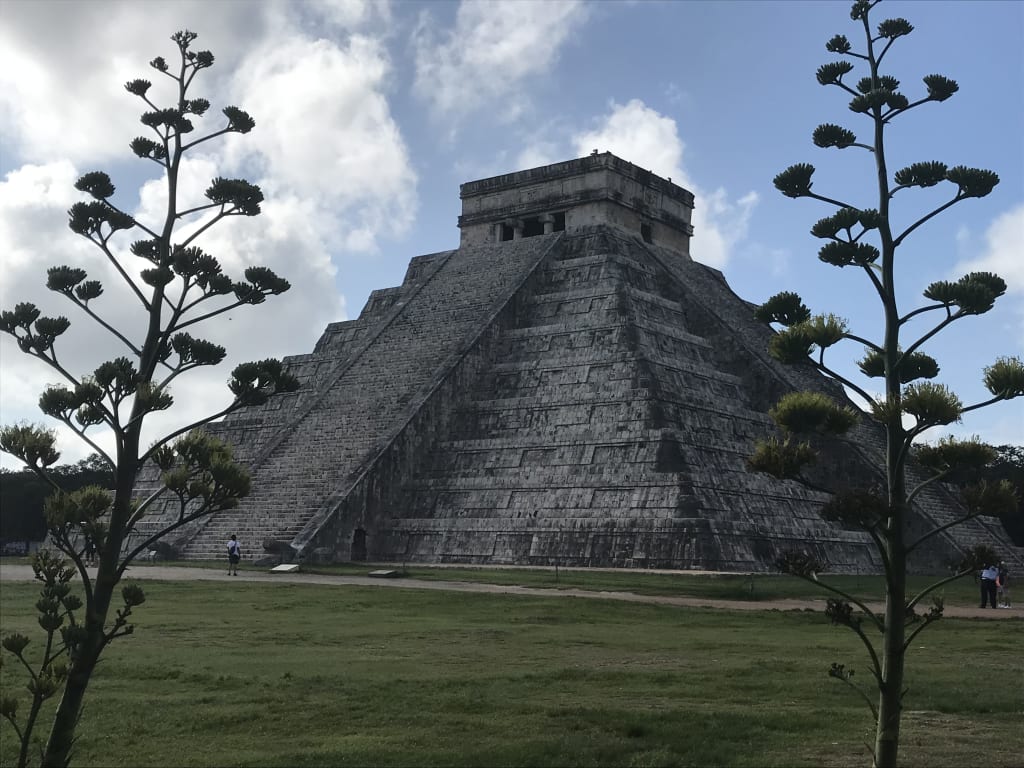
The air hangs hot and humid, reaching nearly 100 degrees Fahrenheit. Sweat trickles beneath your clothing as you move along the pathways. Whispers of long silenced echoes lift in the occasional breeze, surrounding you with an eerie sense of something other worldly, foreboding and long lost. Dust particles stir to settle in your lungs with each breath and step you take beneath the intertwined tree limbs hanging just overhead; they provide relief - momentary shelter from the sun’s rays. Each movement, each stir of dust leads you one step closer to whatever beckons. Not knowing exactly what you will find ahead, you still obey the summons. It's that for which you traveled so far inland.
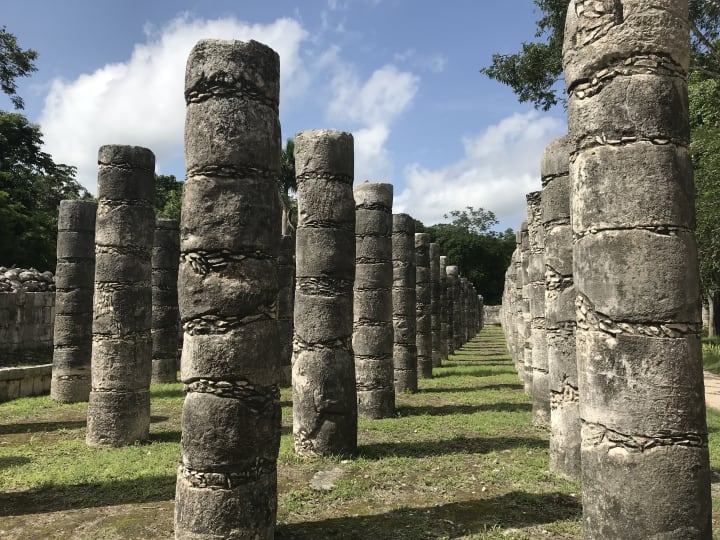
At the end of the lengthy path, you clear the tree filled lane and step into a grass-filled field, nearly blinded by the blazing sun overhead. Before your eyes, it materializes directly before you, as though from the depths of your imagination: a large, imposing ancient structure in an otherwise desolate region. It dominates, demanding your complete attention as ancient wonders envelop and fill your senses. Chichén Itzá, Mexico’s massive, immortalized and meticulously designed Mayan city in the Yucatan state, its largest pyramid, El Castillo, front and center as you enter the clearing. The wind unexpectedly surfaces and whips about you with an unexpected force as the ruins seem to speak without words of the many dead, those sacrificed in ritualistic Mayan ceremonies. While those unfortunate souls are long gone, they are hardly forgotten, their skulls eternalized, etched on and lining more than one stone structure in the ancient city.
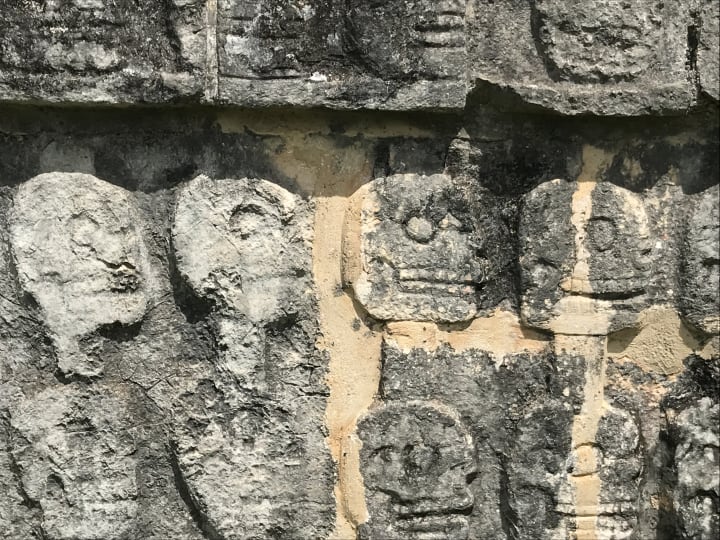
Wandering throughout the geometric assemblage of several carefully constructed stone edifices, lingering echoes of the past permeate your being, filling you with a tumultuous array of emotions. At first, you are not sure how you should feel - its only the sheer wonder of it all enraptures you. Your mind questions the reality of such a structure and ancient city. How on earth did they build such a magnificent pyramid and other gigantic structures during such a primitive time? It all appears quite unfathomable, nearly surreal, and you’re left to wonder about the possibility of aliens assisting with its construction in the face of such impossible feats. As you walk and begin to take note of the many details, the wonder begins to dissipate ever so slowly, and you’re left with something more that fills your soul akin to a profound sadness. A need to weep encompasses.
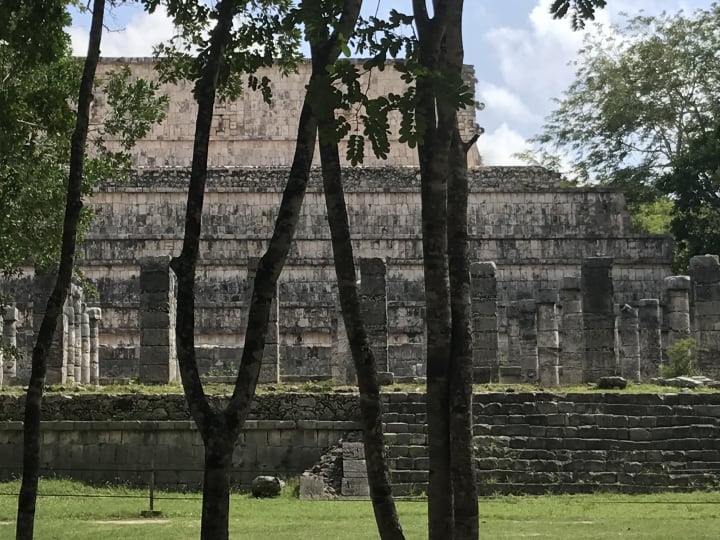
Skulls. Skulls appear in your line of vision everywhere you look. Stone walls and structures are filled with rows upon rows of carved images of skulls, symbolic of those sacrificed years earlier in crude, ritualistic Mayan ceremonies. Seeing the vast number of emblazoned skulls is unsettling and sets your mind on a path to wonder just how many people were chosen each day – or each month – for the supposed sacrificial "honor". You are torn between wanting to understand more about the Mayans' daily existence in 700 AD whilst being horrified at the thought of such primitive barbaric, rituals.
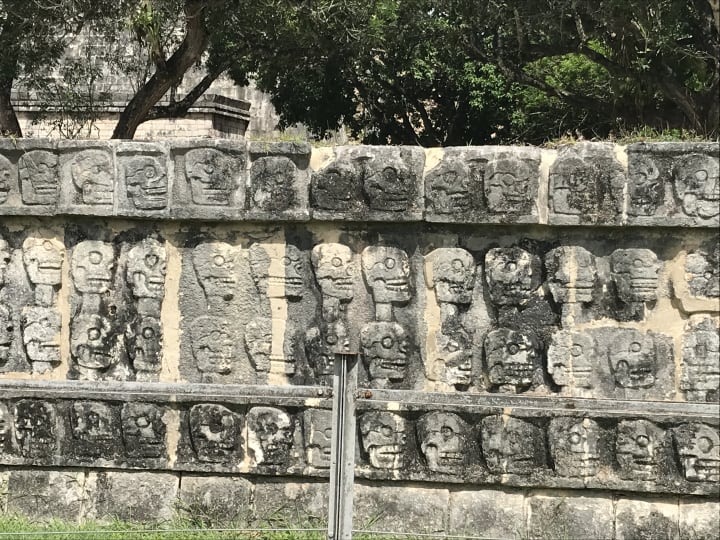
In addition to skulls, there are a multitude of snakes and jaguars, their images and sculptures reflected on many stone edifices. Both of these creatures were thought to be deities and worshipped by the Mayan people. Due to years of repeated climbing and episodes of graffiti by tourists, it is now forbidden to ascend the steps of the large pyramid; however, the steps are so steep, it’s likely that not every individual might want to attempt the endeavor. There is reported to be a large, red jaguar at its peak with jade-jeweled eyes, which was worshipped and the primary sacrificial spot. Vendors along the paths of the property sell an assortment jaguars and snakes, each carved from onyx or wood, and each replicating the sacred gods of the Mayans.
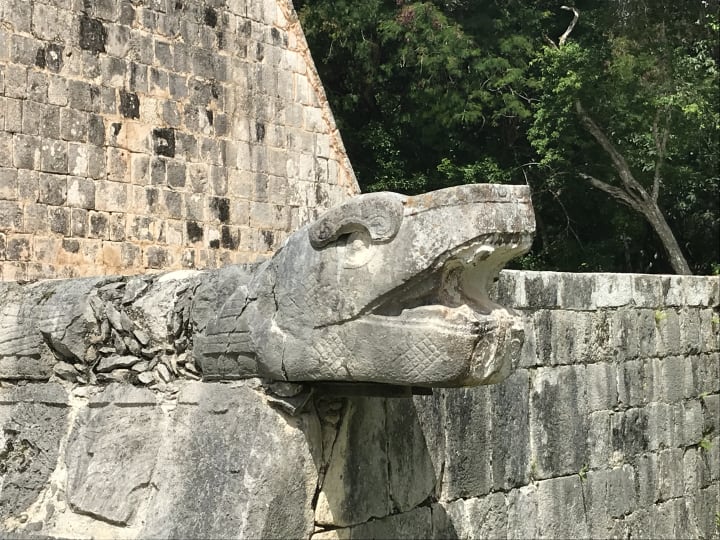
You’re wandering a bit aimlessly, attempting to see all that you can in the short amount of time allotted by your tour guide when you turn down a previously untraveled path. There you encounter a new vendor, a middle-aged woman from a nearby rural community who speaks no English, but entreats you instead with her dark brown eyes, beneath the intense heat of the sun, to buy one of her handsewn handkerchiefs. Stopping to look closer at the items in her basket, you’re suddenly uplifted by their simplistic beauty and smile at the woman. Here is something that records your visit to such a famous landmark without focusing on the sacrificial brutality of the Mayans. Instead, each handkerchief reflects a group of people living each day in Chichén Itzá’s massive shadow. Compelled by something unknown, you offer her forty dollars for four small handkerchiefs – much more than the amount she’s requesting. You instinctively know this woman feeds her family with the sale of the simply sewn handkerchiefs, and you cannot find it in yourself to barter for the purchase of her treasured goods. Each handkerchief is lovingly stitched with a flower or an image of the pyramid along with the words “Recuerdo de Chichén Itzá” – “Do Not Forget Chichén Itzá”.
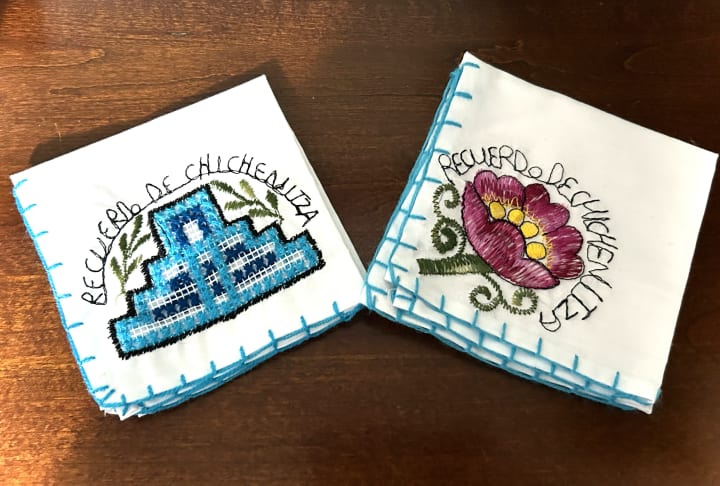
It is the end of the visit and you make your way back to the van where the tour guide and host waits. You’re very glad you made the two-hour trip from relaxing, luxurious Cancun to see one of the New 7 Wonders of the World (that’s another check off your bucket list), but it’s left you overwhelmed with a depth of unexpected emotion. Vibration resonates in you as you settle back in the van, looking out the window to the receding land of Chichén Itzá . While immensely interesting and impressive, what you’ve seen has been difficult to fathom, and even more difficult when it comes to understanding such a primitive way of existence. While being extremely thankful for the experience and the historical information gleamed during my visit, you know the most and most impressive memory you’ll take home. Try as you might, you will never forget the woman with her dark brown, pleading eyes, though the few words you exchanged with her were stilted, broken Spanish and the handkerchiefs simple, sewn cloths for this unknown woman, for you, remains the embodiment and essence of Chichén Itzá.
Recuerdo de Chichén Itzá.....Always.
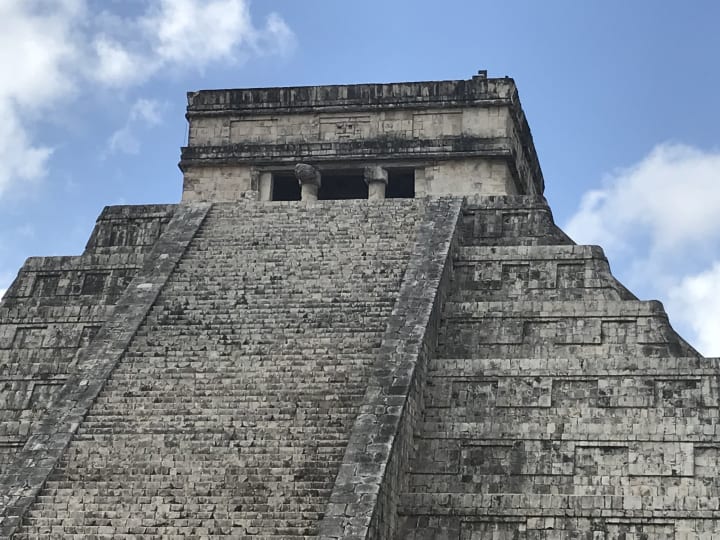
NOTES & REFERENCES:
Chichén Itzá is reported to have been constructed between 600-900 AD during the Terminal Classic Period of the Mayan lowlands, with secondary construction completing closer to 900 AD. It was a powerful Mayan city in the northern part of the Yucatan Mexican state. The name translates to “at the mouth of the well of the Itza”. The naturally formed open well or water-formed sinkhole (known as the cenote sagrado or sacred well), enabled the Mayan people to participate in water-borne peninsular trade along the north coast while also providing them with necessary water for everyday living. The cenote is located near the rear of the property but remains fenced off from tourists as it declines into a deep, unstable area and is under renovation. Archeological records prove that the city was looted by groups of individuals, including the Spanish over the years. The ancient Mayan city, according to historians, met its decline and desolation at some point in the 10th century. It remained hidden beneath lush and overwhelming shrubbery growth until 1841 when an American explorer by the name of John Lloyd Stephens. In 1894, Chichén Itzá was purchased by Edward Herbert Thompson. Following his death in 1935, the Mexican Supreme Court reclaimed Chichén Itzá and restored ownership to its heirs in 1944. The ruins now are now considered federal property, and the site's stewardship is maintained by Mexico's Instituto Nacional de Antropología e Historia (National Institute of Anthropology and History).
Reference: https://en.wikipedia.org/wiki/Chichen_Itza
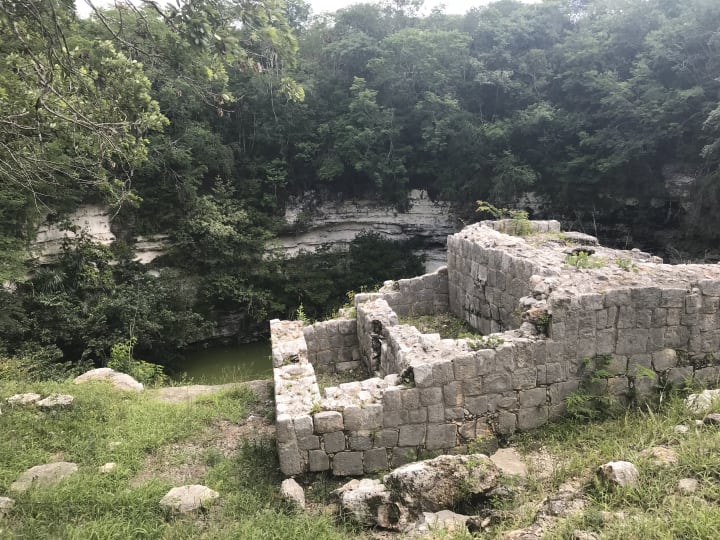
About the Creator
Cindy Calder
From Charleston SC - "I am still learning." Michelangelo
Enjoyed the story? Support the Creator.
Subscribe for free to receive all their stories in your feed. You could also pledge your support or give them a one-off tip, letting them know you appreciate their work.
Reader insights
Nice work
Very well written. Keep up the good work!
Top insight
On-point and relevant
Writing reflected the title & theme




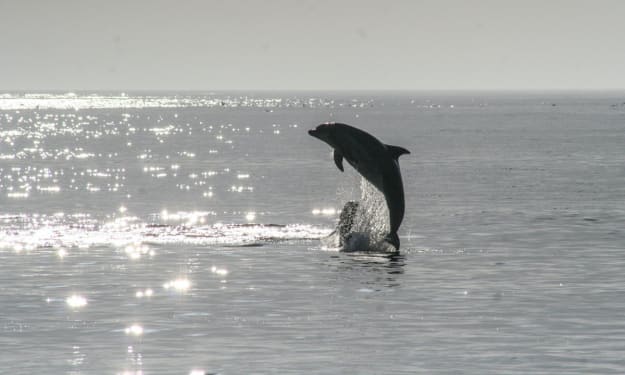

Comments (1)
I was particularly struck by your vivid descriptions and the emotional depth you conveyed. The juxtaposition of the past and present, coupled with your reflections on the importance of memory, resonated deeply with me. Your writing serves as a poignant reminder of the importance of preserving our collective history and the personal stories that shape our understanding of the world. Thank you for sharing your journey and insights with such honesty and eloquence. "Never Forget" is a testament to your ability to touch the hearts of your readers and to evoke a deep sense of reflection and empathy. I look forward to reading more of your work and exploring the stories and experiences you continue to share. Warm regards, Dr. Jay